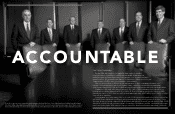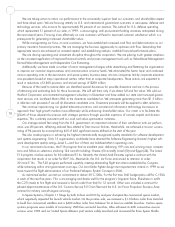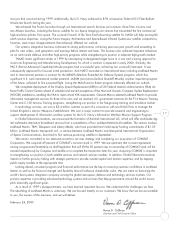Lockheed Martin 1999 Annual Report Download - page 19
Download and view the complete annual report
Please find page 19 of the 1999 Lockheed Martin annual report below. You can navigate through the pages in the report by either clicking on the pages listed below, or by using the keyword search tool below to find specific information within the annual report.
26
MANAGEMENT’S DISCUSSION AND ANALYSIS OF FINANCIAL CONDITION
AND RESULTS OF OPERATIONS
(Continued)
December 31, 1999
subject to certain conditions, of up to 101 RD-180 booster
engines for use in two models of the Corporation’s Atlas
launch vehicle. Terms of the agreements call for payments
to be made to RD AMROSS upon the achievement of cer-
tain milestones in the development and manufacturing
processes. Approximately $55 million of payments made
under these agreements were included in the Corporation’s
inventories at December 31, 1999.
Results of Operations
The Corporation’s operating cycle is long-term and involves
many types of production contracts with varying production
delivery schedules. Accordingly, the results of a particular
year, or year-to-year comparisons of recorded sales and
profits, may not be indicative of future operating results.
The following comparative analysis should be viewed in
this context.
The Corporation’s consolidated net sales for 1999
were $25.5 billion, a decrease of three percent compared
to 1998. Net sales during 1998 were $26.3 billion, a
decrease of six percent compared to 1997. The net sales
decrease in the Space Systems segment in 1999 more
than offset increases in the remaining business segments.
In 1998, slight increases in net sales in the Systems Inte-
gration and Aeronautical Systems segments compared
to 1997 were more than offset by decreases in the other
business segments. The U.S. Government remained the
Corporation’s largest customer, comprising approximately
71 percent of the Corporation’s net sales for 1999 com-
pared to 70 percent in 1998 and 66 percent in 1997.
The Corporation’s operating profit (earnings before
interest and taxes) for 1999 was approximately $2.0 billion,
a decrease of 20 percent compared to 1998. Operating
profit for 1998 was approximately $2.5 billion, a decrease
of nine percent compared to 1997. The reported amounts
for the three years presented include the financial impacts
of various nonrecurring and unusual items, the details of
which are described below. Excluding the effects of these
nonrecurring and unusual items for each year, operating
profit for 1999 would have decreased by 34 percent com-
pared to 1998, and would have decreased by five percent
for 1998 compared to 1997. For 1999 compared to
1998, decreases in operating profit at the Space Systems
and Aeronautical Systems segments more than offset the
slight increase in operating profit at the Systems Integration
and Technology Services segments. For 1998 compared
to 1997, increases in operating profit at the Aeronautical
Systems and Systems Integration segments were more than
offset by reductions in operating profit in the remaining
segments. For a more detailed discussion of the operating
results of the business segments, see “Discussion of Business
Segments” below.
Operating profit in 1999 included the effects of non-
recurring and unusual items which on a combined basis,
net of state income taxes, increased operating profit by
$249 million. These items included a $155 million gain
related to the sale of the Corporation’s remaining interest
in L-3, a $57 million gain associated with the sale of sur-
plus real estate, and a net gain of $37 million associated
with the sale of non-core businesses and investments and
other portfolio shaping actions.
Operating profit in 1998 included the effects of non-
recurring and unusual items which on a combined basis,
net of state income taxes, decreased operating profit by
$162 million. These items included a $233 million charge
related to the timely non-bankruptcy shutdown of CalComp
Technology, Inc. (CalComp), a majority-owned subsidiary
of the Corporation. The Corporation’s decision to finance
’96
’97
’98
Net Sales
$0
$12,000
$18,000
$24,000
$30,000
(In millions)
$6,000
’99’98’97
























